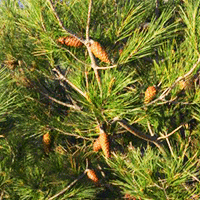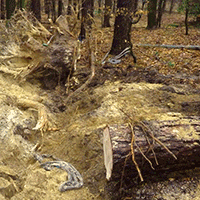
Four decades of forest succession in the oak-dominated forest reserves in Slovakia
Milan Saniga, Miroslav Balanda , Stanislav Kucbel, Ján Pittner
iForest - Biogeosciences and Forestry, Volume 7, Issue 5, Pages 324-332 (2014)
doi: https://doi.org/10.3832/ifor0996-007
Published: Apr 17, 2014 - Copyright © 2014 SISEF
Research Articles
Abstract
The study analyzes biodiversity, production and recovery processes in the natural oak-dominated forests in three protected areas in time span of four decades after the cessation of human impact. In each forest reserve, we established three permanent research plots of 0.5 ha, which were monitored regularly every 10 years. The obtained results confirmed an expected decrease of oak in all investigated areas, regardless of the level of past human intervention. Growth rates of oak stem density were negative in all reserves and ranged from -0.7% yr-1 (Kašivárová) to -2.1% yr-1 (Bujanov). A typical rotated-sigmoid diameter structure was confirmed during the whole observed period only in the reserve Boky. The moderate affected reserve (Kašivárová) showed a bimodal pattern and the most affected reserve (Bujanov) revealed the typical unimodal distribution. Considering spatial diversity, the recorded structure of investigated forests closely corresponds with the relative level of past intervention. In Boky, the most differentiated structure was reflected in the highest long-term mean stem density (890 ± 151 ha-1) and the lowest basal area and growing stock (36.5 ± 1.4 m2 ha-1 and 284 ± 22 m3 ha-1, respectively). The past-affected reserves reached higher values of basic stand parameters. In Kašivárová and Bujanov, the average basal area (36.5 and 44 m2 ha-1, respectively) and growing stock (284 and 518 m3 ha-1, respectively) correlated negatively with the level of structural heterogeneity, while the stem number revealed a positive correlation. We observed a continuous increase of deadwood volume and dead to live wood ratio. The recorded long-term volume of deadwood (43-128 m3 ha-1) and deadwood proportion (151-28%) tended to be higher in the past-affected reserves. The convergence towards the rotated-sigmoid distribution in both reserves with past human impact was recorded. Considering the vertical structure, the most dynamic changes were observed in the lower and middle layer. Moreover, the substitution of the light-demanding oak by shade-tolerant species (beech, hornbeam) was recorded. The intensity of substitution directly reflected the intensity of structure modification in the past. Our results suggest that the process of forest recovery and oak loss significantly depends on the level of past human intervention.
Keywords
Oak Decline, Past Human Impact, Recovery, Forest Reserve, Quercus petraea L
Authors’ Info
Authors’ address
Miroslav Balanda
Stanislav Kucbel
Ján Pittner
Technical University in Zvolen, T. G. Masaryka 24, SK 960-53 Zvolen (Slovak Republic)
Corresponding author
Paper Info
Citation
Saniga M, Balanda M, Kucbel S, Pittner J (2014). Four decades of forest succession in the oak-dominated forest reserves in Slovakia. iForest 7: 324-332. - doi: 10.3832/ifor0996-007
Academic Editor
Emanuele Lingua
Paper history
Received: Mar 22, 2013
Accepted: Feb 03, 2014
First online: Apr 17, 2014
Publication Date: Oct 01, 2014
Publication Time: 2.43 months
Copyright Information
© SISEF - The Italian Society of Silviculture and Forest Ecology 2014
Open Access
This article is distributed under the terms of the Creative Commons Attribution-Non Commercial 4.0 International (https://creativecommons.org/licenses/by-nc/4.0/), which permits unrestricted use, distribution, and reproduction in any medium, provided you give appropriate credit to the original author(s) and the source, provide a link to the Creative Commons license, and indicate if changes were made.
Web Metrics
Breakdown by View Type
Article Usage
Total Article Views: 53944
(from publication date up to now)
Breakdown by View Type
HTML Page Views: 45486
Abstract Page Views: 3194
PDF Downloads: 3980
Citation/Reference Downloads: 33
XML Downloads: 1251
Web Metrics
Days since publication: 4281
Overall contacts: 53944
Avg. contacts per week: 88.21
Citation Metrics
Article Citations
Article citations are based on data periodically collected from the Clarivate Web of Science web site
(last update: Mar 2025)
Total number of cites (since 2014): 23
Average cites per year: 1.92
Publication Metrics
by Dimensions ©
Articles citing this article
List of the papers citing this article based on CrossRef Cited-by.
References
Prirodzené rozšírenie lesných drevín na Slovensku [Natural distribution of forest tree species in Slovakia]. SVPL, Bratislava, Slovakia, pp. 402. [in Slovak]
Gscholar
Karte der natürlichen Vegetation Europas [Map of the Natural Vegetation of Europe]. Bundesamt für Naturschutz, Bonn, Germany, pp. 11. [in German]
Gscholar
Insights from 50 years of research in natural forest dynamics in Switzerland. In: Proceedings of the “4th Symposium of the Hohe Tauern National Park Conference. Volume for Research in Protected Areas”. Castle of Kaprun (Austria) 17-19 September 2009. Hohe Tauern National Park Council, Matrei in Osttirol, Austria, pp. 41-44.
Gscholar
Waldreservate. 50 Jahre natürliche Waldentwicklung in der Schweiz [Forest reserves. 50 years of the natural succession in the Switzerland]. Haupt, Bern, Switzerland, pp. 272. [in German].
Gscholar
Viac pozornosti hromadnému hynutiu dubov v chránených územiach [More attention for the natural oak decline]. Pamiatky prírody 1: 26-27. [in Slovak]
Gscholar
Eichensterben in Norddeutschland - Verbreitung, Schadbilder, moegliche Ursachen [Oak decline in northern Germany - extent, examples, possible causes]. Forst & Holz 44: 475-487. [in German]
Gscholar
Lesnícky inventarizačný výskum v ŠPR Bujanov [Forestry inventory in NNR Bujanov]. ŠOP, Prešov, Slovakia, pp. 7. [in Slovak]
Gscholar
Diagnostic, constant and dominant species of the higher vegetation units of Slovakia. Veda, Bratislava, Slovakia, pp. 332.
Gscholar
Dejiny lesníctva a drevárstva na Slovensku [History of the forestry and timber industry in Slovakia]. Veda, Martin, Slovakia. [in Slovak]
Gscholar
Pralesy Slovenska [Slovak primeval forests]. Veda, Bratislava, Slovakia, pp. 332. [in Slovak]
Gscholar
Die Urwälder der Westkarpaten [Virgin forests in western Carpathians]. Gustav Fischer Verlag, Stuttgart, Germany, pp. 310. [in German]
Gscholar
Europäische Urwälder. Wegweiser zur naturnahen Waldwirtschaft [European virgin forests. A guide to close-to-nature forest management]. Haupt, Bern, Stuttgart, Wien, pp. 260. [in German]
Gscholar
Eichenwelken in der Slowakei [Oak decline in Slovakia]. Österreichische Forstrzeitschrift 98: 51-52. [in German]
Gscholar
Der thermophile eichenwald in NO-Polen als anthropozoogene Gesellschaft [The thermophile oak forest in NE Poland as the anthropic community]. In: “Vegetation und Fauna” (Tüxen R, Cramer J eds). Berichte der Internationalen Symposien der Internationalen Verein für Vegatationskunde, Vaduz, Liechtenstein, pp. 527-540. [in German]
Gscholar
Research in forest reserves and natural forests in European countries. EFI Proceedings No 16. European Forest Institute, Joensuu, Finland, pp. 304.
Gscholar
Sústava česko-slovenských objemových tabuliek dreva [Czechoslovak tables of timber volumes]. Lesnícky časopis 37: 49-56. [in Slovak]
Gscholar
Forest dynamics, growth an yield: from measurement to model. Springer-Verlag, Freising, Germany, pp. 670.
Gscholar
Structure of coarse woody debris in Lange-Leitn Natural Forest Reserve, Austria. Journal of Forest Science 54: 161-169.
Gscholar
Driving factors of a vegetation shift from Scots pine to pubescent oak in dry Alpine forests. Global Change Biology 19: 229-240.
CrossRef | Gscholar
Relation of dead wood course within the development cycle of selected virgin forests in Slovakia. Journal of Forest Science 48: 513-528.
Gscholar
Štruktúra a regeneračné procesy dubového pralesa v NPR Kašivárová [Structure and regeneration of oak old-growth forest in NNR Kašivárová]. Ochrana prírody 24: 21-33. [in Slovak]
Gscholar
A review of approaches to forestry research on structure, succession and biodiversity of undisturbed and semi-natural forests and woodlands in Europe. Working paper 3, European Forest Institute, Joensuu, Finland, pp. 64.
Gscholar
Oak decline in Europe. In: Proceedings of the International Symposium “Oak decline in Europe”. Kornik (Poland) 15-18 May 1990. Polish Academy of Sciences, Kornik, Poland, pp. 360.
Gscholar
Banater Urwälder [Virgin forests of Banater]. Verlag Mirton, Temesvar, Romania, pp. 198. [in German]
Gscholar
Dendrometria [Dendrometry]. Vydavatelstvo Technickej University, Zvolen, Slovakia, pp. 399. [in Slovak]
Gscholar
Štruktúra a velkost porastových medzier v NPR Bujanovská dubina [Structure and the gap size in NNR Bujanovská dubina]. Acta Facultatis Forestalis Zvolen 53 (2): 19-28. [in Slovak]
Gscholar
Natural disturbance and patch dynamics, an introduction. In: “The ecology of natural disturbance and patch dynamics” (Pickett STA, White PS eds). Academic Press, New York, USA, pp. 3-13.
Gscholar
Tropical rain forests of the Far East. Clarenden Press, Oxford, UK, pp. 368.
Gscholar

















